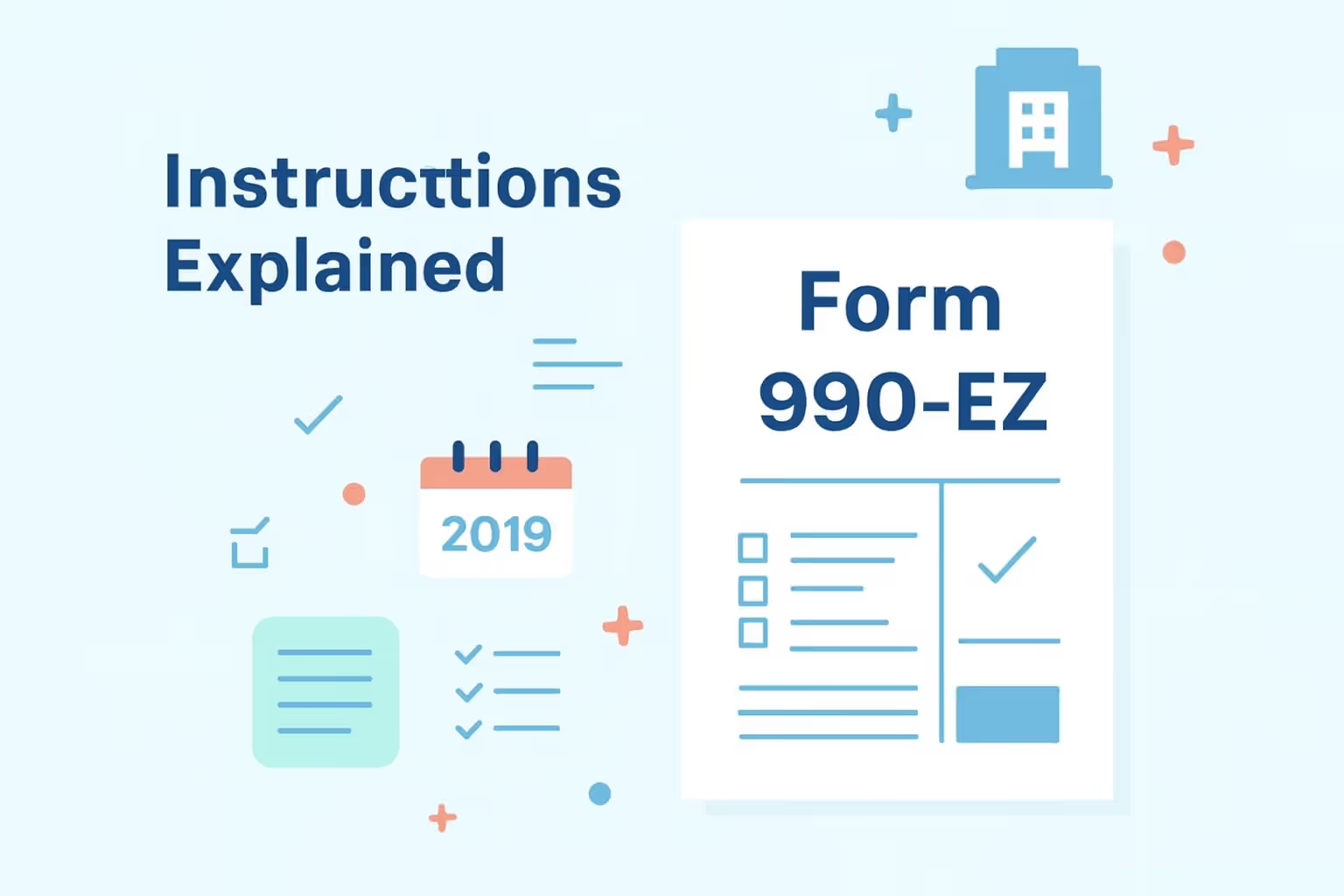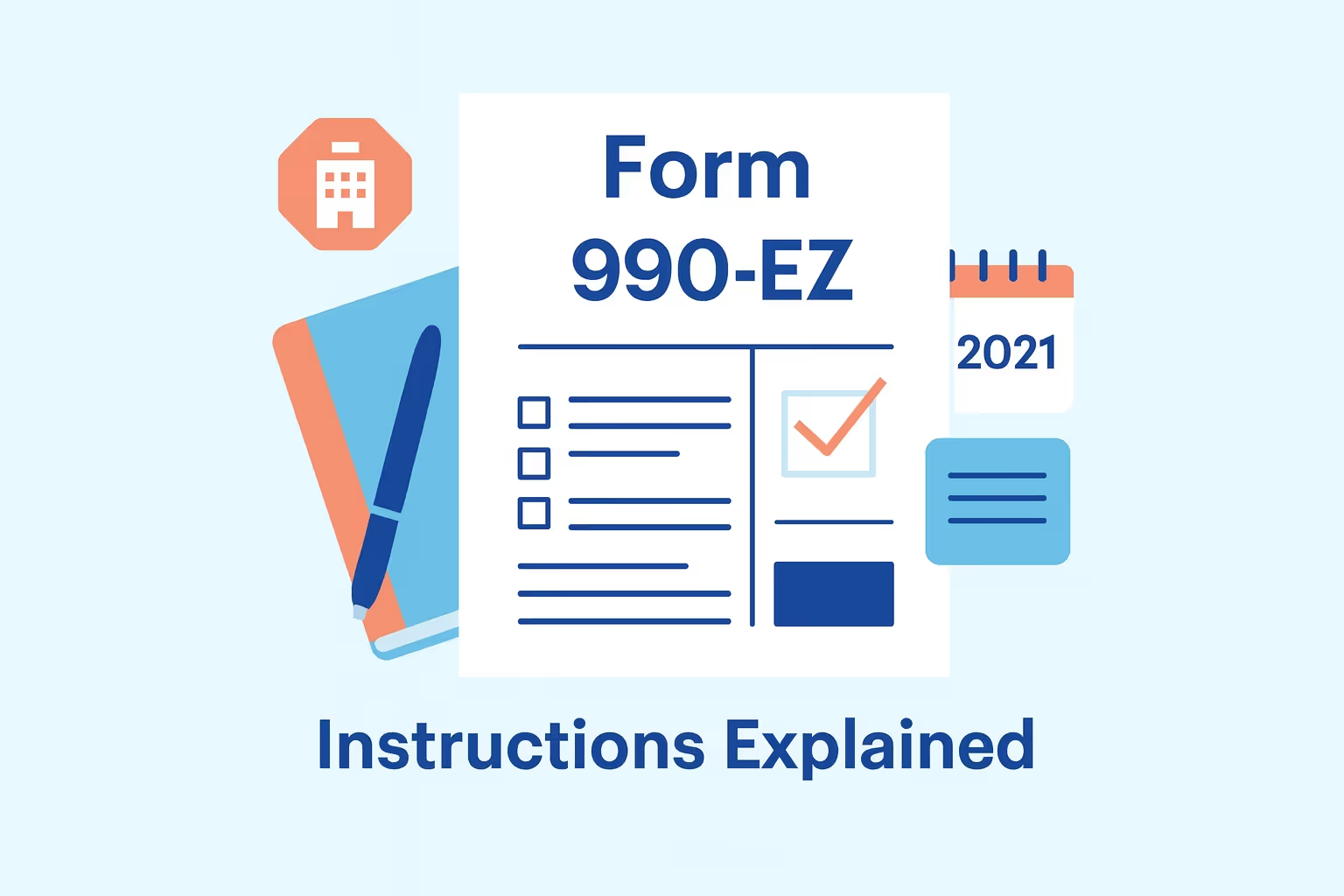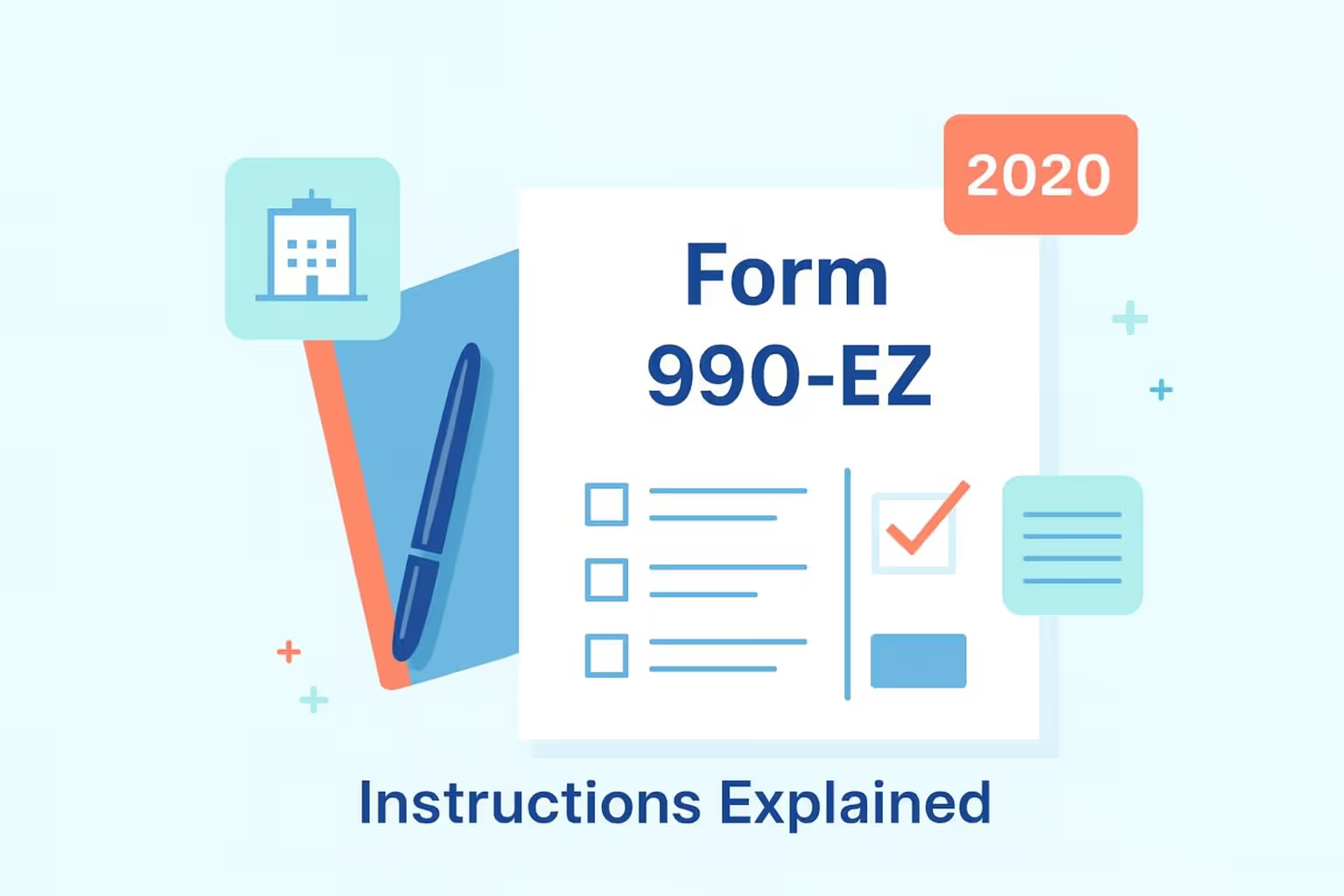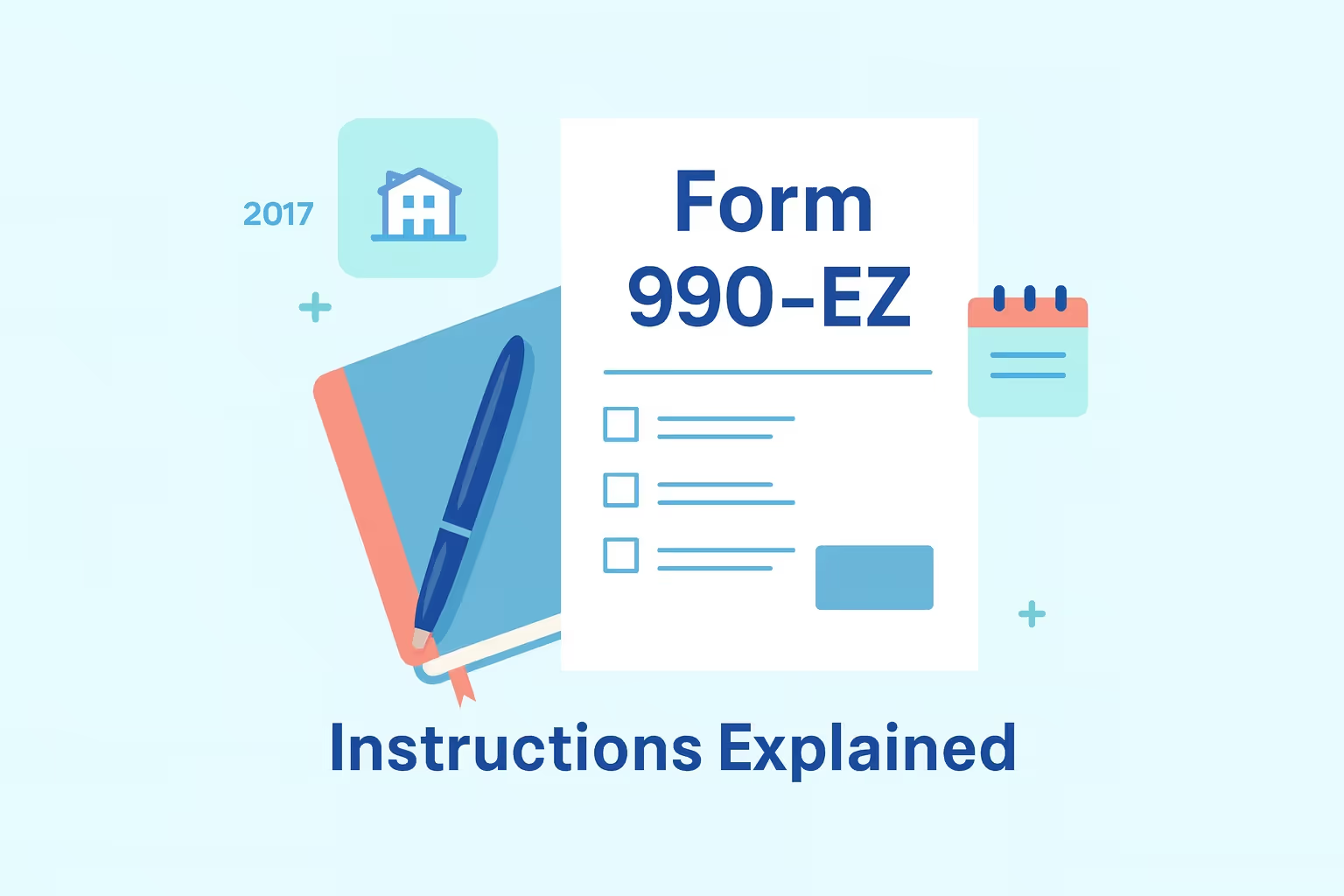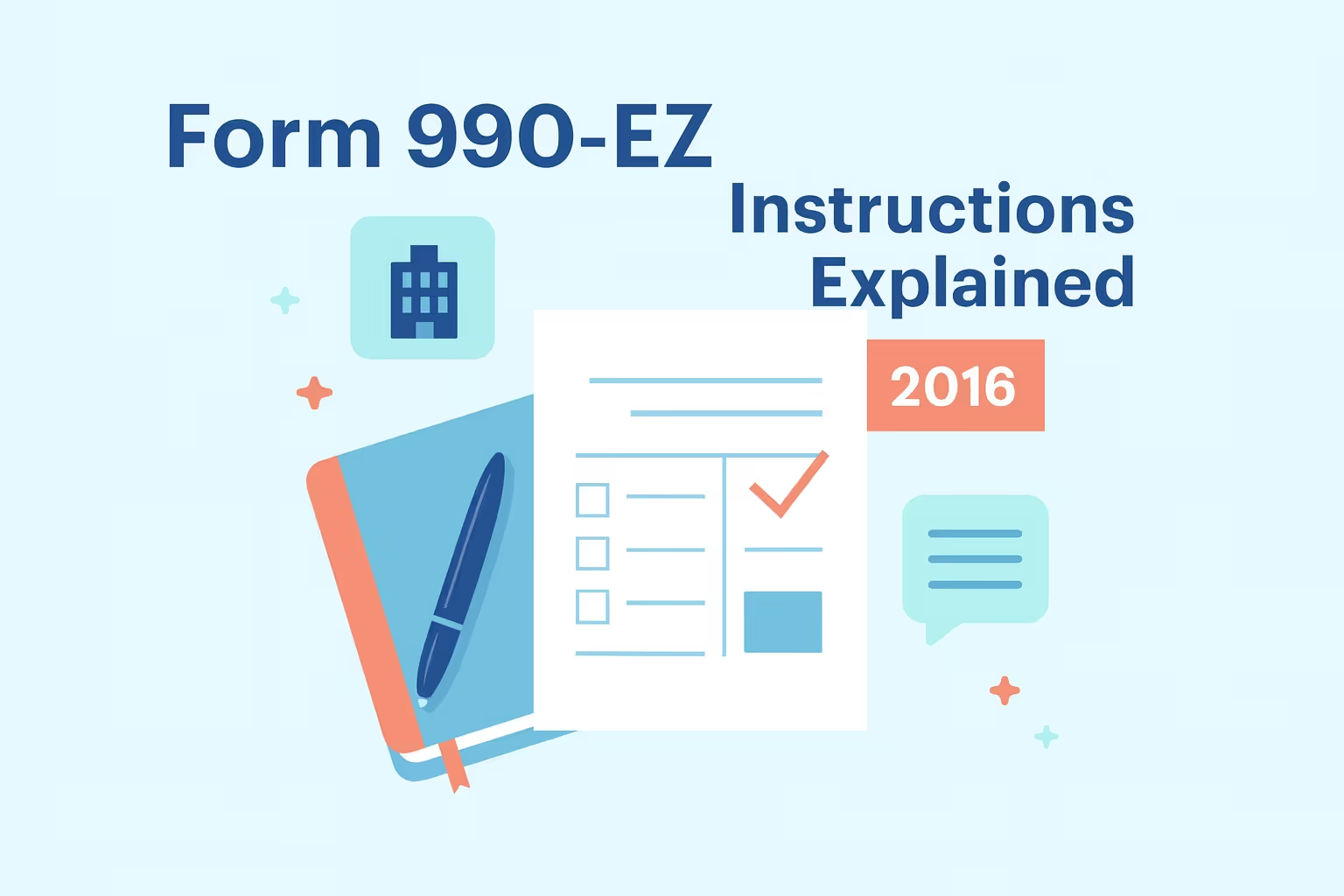How to File Federal Form 990-EZ for Tax Year 2022
According to the Internal Revenue Service, over 1.5 million tax-exempt organizations file returns yearly, and thousands face penalties simply for filing the wrong form or missing key details. Filing Federal Form 990-EZ for Tax Year 2022 may seem straightforward, but minor mistakes can cause serious setbacks. Missing deadlines, overlooking gross receipts, or reporting incorrect totals can lead to delayed public disclosure, revoked tax-exempt status, and avoidable financial penalties.
Form 990-EZ bridges full compliance and unnecessary stress for most small and mid-sized nonprofit organizations. It provides a simplified way to report financial information while maintaining transparency with donors and the Internal Revenue Service. However, completing this short form return requires accuracy, organization, and attention to detail—especially when listing program service accomplishments, net assets, and total revenue.
This article will walk you through how to file Federal Form 990-EZ for Tax Year 2022 correctly and efficiently. You’ll learn eligibility rules, filing thresholds, key sections of the form, and common errors that can delay your refund or threaten your tax-exempt status. Whether you manage a local charity, community foundation, or educational nonprofit, this guide will help you confidently complete your filing process, avoid penalties, and ensure your organization remains in good standing with the IRS.
What Is Federal Form 990-EZ for Tax Year 2022?
The Federal Form 990-EZ for Tax Year 2022 is the IRS short form return designed explicitly for smaller tax-exempt organizations. It helps the Internal Revenue Service and the public understand how the organization operates, spends funds, and furthers its mission. The form balances simplicity and detail, giving smaller nonprofits a streamlined way to report financial information without the extensive disclosures required by the complete Form 990.
Organizations filing this form must operate exclusively under the Internal Revenue Code for charitable, educational, or exempt purposes. It is a compliance tool confirming the organization's eligibility for its tax-exempt status. In addition, it ensures transparency by publicly sharing critical data such as program service revenue, net assets, and total revenue.
By filing Form 990-EZ correctly, organizations demonstrate accountability and maintain public trust. It also reassures donors that funds are used responsibly for the organization’s mission.
Eligibility Criteria and Filing Thresholds
Not every exempt organization can use this simplified form. To qualify, your organization’s gross receipts must be under $200,000 and its total assets must be under $500,000 at the end of the tax year. If your organization exceeds either threshold, you must file Form 990 instead.
The IRS provides clear guidelines to help organizations determine which form applies. For instance, a local community group with $150,000 in gross receipts and $300,000 in assets can file Form 990-EZ, while a regional foundation with higher totals must submit the complete Form 990.
This simplified form still requires thorough reporting of financial statements, program service accomplishments, and key employees, but avoids the most complex schedules attached to larger filings.
Comparison 1: IRS Form Comparison for Tax-Exempt Organizations
- Gross Receipts Threshold: ≤ $50,000
- Total Assets Limit: N/A
- Filing Complexity: Simplest
- Example Organization: Volunteer-run local charity
- Gross Receipts Threshold: < $200,000
- Total Assets Limit: < $500,000
- Filing Complexity: Moderate
- Example Organization: Small nonprofit or youth foundation
- Gross Receipts Threshold: ≥ $200,000
- Total Assets Limit: ≥ $500,000
- Filing Complexity: Detailed
- Example Organization: National public charity or large foundation
Preparing to File Form 990-EZ
Before completing the form, your organization must prepare accurate financial records, confirm its tax-exempt status, and organize all relevant documentation. Careful preparation helps prevent costly mistakes that can delay processing, trigger penalties, or draw unwanted attention from the IRS.
Required Documentation and Financial Information
Your organization must have all supporting documentation ready to complete the Federal Form 990-EZ for Tax Year 2022. Each document provides essential information that ensures your submission is accurate, verifiable, and fully compliant with IRS guidelines.
- Financial statements and balance sheets: Prepare detailed financial statements showing the organization’s total revenue, assets, and fund balances at the end of the tax year. These figures must match the accounting records and reflect any significant disposition or acquisition of property. Consistency between internal books and the filed return prevents audit complications.
- Program service accomplishments: Write concise summaries describing your organization’s primary programs and measurable outcomes. Each description should demonstrate how your organization furthers its mission and maintains tax-exempt status through community benefit.
- Revenue and expense documentation: Gather receipts, grant letters, and donor acknowledgments that confirm all reported income and expenditures. These supporting materials should align with your gross receipts totals and validate your financial statements.
- Identification numbers and IRS correspondence: Have your employer identification number (EIN), group exemption number, and any official group exemption letter available. Keep copies of previously filed forms, as they provide helpful reference points when comparing year-to-year figures.
- Board and officer information: Verify accurate names, roles, and compensation details for each key employee, director, and assistant treasurer. Ensure the information matches your internal records since discrepancies can delay processing or invite follow-up questions from the IRS.
Collecting these materials before beginning your form allows for a smoother filing process and reduces the likelihood of missing required details.
Confirming Exempt Status and Public Support Classification
Before filing, confirm your organization’s tax-exempt classification with the Internal Revenue Service. You can verify your eligibility through the IRS website or by reviewing your determination letter.
- If your organization operates as a public charity, ensure that your public support percentage meets IRS requirements based on contributions, grants, and program service revenue.
- Private foundations and nonexempt charitable trusts must meet different reporting standards requiring more detailed schedules.
- If your organization holds a group exemption letter, confirm inclusion under the parent organization’s exemption to avoid accidental misfiling.
Maintaining the correct classification is critical for preserving your tax-exempt status and avoiding unnecessary penalties or reclassification by the IRS.
Common Errors to Avoid Before Filing
Even minor oversights can result in rejected forms or IRS delays. Reviewing your materials carefully before filing helps protect your organization’s reputation and compliance record.
- Omitting required schedules: Some organizations fail to attach necessary forms like Schedule A (public charity status) or Schedule O (supplemental information), essential for a complete return.
- Mismatched financial totals: Confirm that the figures for gross receipts, net assets, and total expenses remain consistent across all sections. Mismatched numbers are one of the most common reasons filings are delayed or questioned.
- Incomplete officer listings: Include all board members and key officers, even if they receive no compensation. Missing names can trigger verification requests from the IRS.
- Incorrect tax year selection: Verify that your calendar or fiscal year matches your accounting period. Errors in this section can misalign your reporting cycle and create confusion in future filings.
Completing these checks before you start filling out the form can save hours of correction later and ensure your organization remains in good standing.
Step-by-Step Filing Process
Once your organization’s documents are organized and verified, you can begin completing Federal Form 990-EZ for Tax Year 2022. This step-by-step guide walks you through each part of the form, explains what information to provide, and highlights areas where mistakes commonly occur. Following these steps carefully ensures that your return is accurate and compliant with IRS guidelines.
Part I – Revenue, Expenses, and Changes in Net Assets
- Report total revenue sources accurately: Include all income from contributions, program service revenue, membership dues, and fundraising activities. Each figure should match your financial records and reflect accurate gross receipts for the tax year.
- Account for total expenses completely: List expenses such as grants, benefits to members, and administrative costs. Make sure all expense categories align with your accounting documentation to maintain transparency.
- Calculate changes in net assets correctly: Subtract total expenses from total revenue to determine your net assets. This figure helps the Internal Revenue Service evaluate your organization’s financial stability and stewardship of funds.
Accurate reporting in this section establishes the foundation for the rest of the return and demonstrates your organization’s financial accountability.
Part II – Balance Sheets and Total Assets
- List all assets and liabilities at the end of the tax year: The list should include cash, accounts receivable, investments, and other assets such as property or equipment.
- Ensure totals match financial statements: The IRS may compare your reported totals with previously filed forms so that inconsistencies could trigger additional scrutiny.
- Disclose fund balances clearly: State the organization’s ending fund balances and total assets to show that the books balance. The balance sheet provides a snapshot of the organization’s overall financial position.
Accuracy here is essential because the balance sheet confirms your organization’s fiscal integrity and validates the information reported in Part I.
Part III – Program Service Accomplishments
- Describe each major program in detail: Explain what it does, who it serves, and what results were achieved. Include data such as the number of individuals helped or projects completed.
- Link accomplishments to your organization’s mission: The IRS and the public rely on this section to understand how your organization fulfills its exempt purpose under the Internal Revenue Code.
- Provide measurable outcomes: Specific results—such as “provided 5,000 free meals” or “awarded 20 research grants”—enhance transparency and strengthen public trust.
This section allows your organization to highlight its impact, reinforcing the reason it qualifies for tax-exempt status.
Part IV – Officers, Directors, and Key Employees
- List all key personnel with complete information: Include the assistant treasurer, directors, and other officers responsible for managing the organization. Each individual’s title, average weekly hours, and compensation must be clearly stated.
- Provide compensation details transparently: Report salaries, bonuses, and benefits accurately to reflect fair governance and accountability.
- Verify consistency across filings: Ensure that listed individuals and compensation amounts match prior submissions and your internal payroll records.
This section promotes organizational transparency, helping donors and the public evaluate how leadership compensation aligns with mission outcomes.
Part VI – Supplemental Information and Certification
- Provide explanations for significant changes: Use this section to disclose substantial disposition of assets, mergers, or modifications in governance structure.
- Report political or lobbying activities: Indicate whether your organization engaged in political campaign efforts or lobbying activities during the tax year.
- Certify accuracy and authorize submission: The form must be signed and dated by an authorized officer, confirming that all information is accurate, correct, and complete.
Completing this part thoroughly finalizes your return. Missing or unsigned certifications can invalidate the filing, delaying confirmation of your tax-exempt status.
E-Filing and Submission Guidelines
After completing all sections of Federal Form 990-EZ for Tax Year 2022, the final step is to submit it securely and on time. The Internal Revenue Service strongly recommends electronic filing because it minimizes errors, shortens processing times, and immediately confirms that your return has been received.
How to E-File Form 990-EZ
- Use an IRS-authorized e-file provider: The IRS requires most tax-exempt organizations to file electronically through approved providers listed on the IRS website. These platforms contain built-in validation checks that identify missing data, incomplete schedules, or inconsistencies before submission.
- Upload all required attachments and schedules: Include all necessary forms such as Schedule A (public charity status) and Schedule O (supplemental information). Missing attachments can cause the IRS system to reject your return automatically.
- Submit securely and keep digital confirmation: After submitting, download or print the acknowledgment page confirming receipt. This confirmation proves that your return was filed on time and accepted by the IRS.
Electronic filing is the most efficient and reliable method. It prevents delays caused by mail processing and typically shortens review times from several weeks to a few days.
Filing Deadlines and Extensions
- Know your organization’s due date: For calendar-year filers, the deadline is May 15, 2023. Fiscal-year filers must submit by the 15th day of the fifth month after the end of their fiscal year.
- Request an extension if necessary: If you need more time, file Form 8868 for an automatic six-month extension. Remember that this extension only applies to the filing deadline, not any payments owed.
- Track submission timing carefully: Filing late by even one day can result in penalties or damage your compliance record. Submitting early ensures time to correct errors or technical issues before the IRS deadline.
Avoiding Penalties and Additional Fees
- Understand penalty calculations: The IRS can impose a penalty of 5% per month for failure to file and up to 10% for failure to pay, depending on your organization’s classification.
- Ensure your form is complete and accurate: Double-check every section, including officer details, schedules, and totals. Incomplete or inaccurate filings can result in rejection and additional administrative fees.
- Retain all submission records: Keep copies of your electronic return, acknowledgment receipt, and any correspondence with the IRS. These documents serve as verification in case of future audits or inquiries.
Timely, accurate filing prevents penalties and strengthens your organization’s reputation for transparency and accountability.
Comparing Form 990-EZ with Other IRS Forms
Choosing the correct form is one of the most critical steps in maintaining your organization’s tax-exempt status. Filing the wrong form can cause unnecessary delays, penalties, or even a loss of exemption. Understanding how Federal Form 990-EZ for Tax Year 2022 compares to other filings ensures that your organization meets its reporting requirements under the Internal Revenue Code.
Differences Between Form 990, 990-EZ, and 990-N
- Understand the purpose of each form: The Form 990 series is designed to match different organization sizes and financial thresholds. Smaller organizations use Form 990-N, mid-sized groups use Form 990-EZ, and larger nonprofits complete the full Form 990. Each form requires different levels of financial detail and supporting documentation.
- Recognize reporting depth and complexity: Form 990 requires detailed financial reporting, governance disclosures, and a full breakdown of expenses and revenues. In contrast, Form 990-EZ provides a summarized approach with fewer required schedules, while Form 990-N is a simple electronic notice for organizations with minimal gross receipts.
- Know how your form affects public visibility: Form 990 submissions are publicly available and reviewed by donors, watchdog organizations, and the general public. Choosing the appropriate form ensures that your organization’s financial transparency matches its size and resources.
Comparison 2: Form 990 vs. Form 990-EZ Reporting Requirements
- Form 990: Detailed by category
- Form 990-EZ: Summarized
- Form 990: Mandatory
- Form 990-EZ: Limited
- Form 990: Full financial statements required
- Form 990-EZ: Condensed summary
- Form 990: High
- Form 990-EZ: Moderate
When to Use Form 990-EZ Instead of Form 990
- Confirm your organization’s eligibility: Use Form 990-EZ if your organization’s gross receipts are less than $200,000 and total assets are below $500,000 at the end of the tax year. Filing this form saves time while meeting all IRS compliance requirements.
- Consider organization type and structure: Smaller public charities, religious organizations, and public safety nonprofits typically use Form 990-EZ because it meets their reporting needs without unnecessary complexity.
- Review for consistency across years: If your organization’s size fluctuates, ensure consistency in reporting by filing the correct form each year. When your gross receipts exceed the threshold, you must transition to Form 990 to maintain accurate records with the Internal Revenue Service.
Best Practices for Accuracy and Compliance
Accuracy is critical when filing Federal Form 990-EZ for Tax Year 2022. Even minor errors can lead to penalties, processing delays, or questions from the Internal Revenue Service. Following best practices ensures a smooth filing process and protects your organization’s reputation and long-term tax-exempt status.
Double-Check Financial Information
- Reconcile totals before submission: Verify that the figures for total revenue, total assets, and net assets match across Parts I and II of your form. Inconsistencies can raise red flags and may result in an IRS review or request for clarification.
- Cross-reference with financial statements: Compare your reported figures against your organization’s financial statements and balance sheet. Matching data ensures your return accurately reflects your financial position.
- Confirm all schedule attachments: Review required schedules and supporting documentation, such as Schedule O or Schedule A, to confirm they are attached and complete. Missing schedules often cause processing delays or rejection notices.
Double-checking ensures the form represents your organization’s actual financial performance and compliance with reporting requirements.
Maintain Transparent Records for Public Disclosure
- Retain completed forms for at least three years: Keep digital and printed copies of your completed form, including schedules and attachments. Under federal transparency laws, these documents must be available for public inspection upon request.
- Organize supplemental documentation systematically: Maintain organized records for program service revenue, grants, and donor contributions. Structured recordkeeping simplifies audits and builds credibility with donors and regulatory agencies.
- Review disclosures for accuracy and clarity: Confirm that information about program service accomplishments, fund balances, and key employees is clear, factual, and consistent across all filings. Transparency reinforces donor confidence and public trust.
Keeping well-documented records supports compliance and the organization’s credibility as a responsible steward of charitable funds.
Seek Professional Help if Needed
- Consult a qualified tax professional: Hire a CPA or enrolled agent if your organization faces complex issues such as significant property dispositions, research grants, or multi-branch reporting under a group exemption letter. Expert guidance can prevent costly filing mistakes.
- Use e-file systems to save time: The IRS encourages electronic filing to ensure faster processing, fewer errors, and greater data security. Electronic systems guide you through required fields, reducing the likelihood of omissions.
- Address potential issues proactively: If your organization discovers discrepancies or compliance concerns before submission, resolve them immediately. Proactive problem-solving prevents potential fines and protects your tax-exempt status.
FAQs
What is the filing deadline for Federal Form 990-EZ for Tax Year 2022?
The filing deadline is the 15th day of the fifth month after your organization’s tax year ends. For calendar-year filers, this date is May 15, 2023. You can request a six-month extension using Form 8868 if additional time is needed. Filing electronically through an IRS-approved provider ensures that your submission is accurate, complete, and timely received by the Internal Revenue Service.
Can a religious organization file Form 990-EZ?
Most churches, associations of churches, and integrated auxiliaries are automatically exempt from income tax and not required to file Form 990-EZ. However, related entities, charitable trusts, or affiliated ministries that operate as separate tax-exempt organizations must still submit the correct form. Confirming filing obligations through the IRS website is essential to avoid compliance issues and maintain exemption eligibility.
What happens if I file the wrong form?
Filing the wrong form can delay processing, affect public charity status, or lead to late penalties. For example, organizations that should file Form 990 but instead submit Form 990-EZ may need to refile the correct form. Always review IRS instructions and thresholds before filing to ensure your submission matches your organization’s size, gross receipts, and total assets.
How do I fix an error after filing Form 990-EZ?
If an error is discovered after submission, file an amended return marked “Amended” at the top of the form. Include updated figures and attach any required schedules. Electronic filing is the best method to submit corrections quickly and securely. Always review your revised submission for accuracy to ensure the Internal Revenue Service processes the updated form without delays.
Does filing Form 990-EZ affect an organization’s exempt status?
Yes, filing Form 990-EZ annually helps confirm your organization’s tax-exempt status under the Internal Revenue Code—failure to file for three consecutive years results in automatic revocation of exemption. Once revoked, the organization must reapply for recognition using Form 1023 or Form 1023-EZ. Maintaining accurate filings helps prevent loss of exemption and demonstrates your organization’s ongoing eligibility as a compliant exempt organization.
















